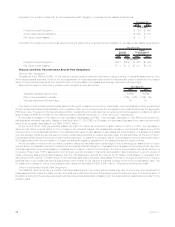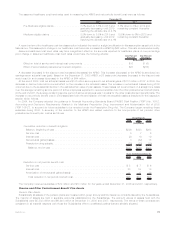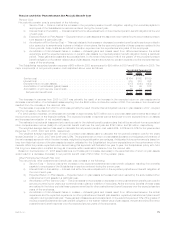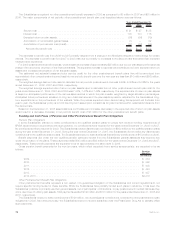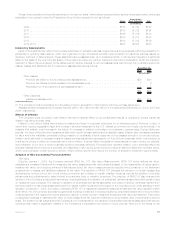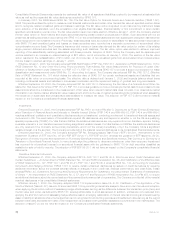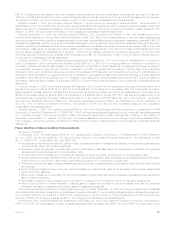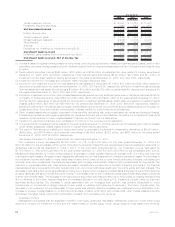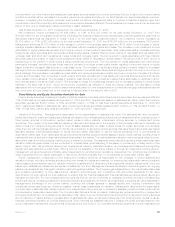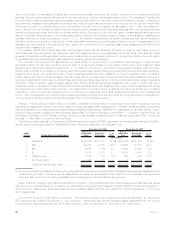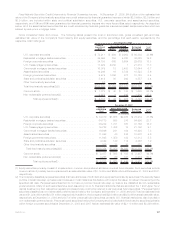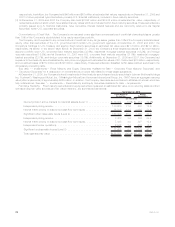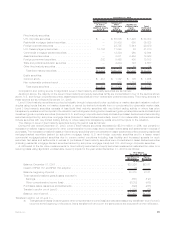MetLife 2008 Annual Report Download - page 83
Download and view the complete annual report
Please find page 83 of the 2008 MetLife annual report below. You can navigate through the pages in the report by either clicking on the pages listed below, or by using the keyword search tool below to find specific information within the annual report.(ii) recognition as an adjustment to accumulated other comprehensive income (loss), net of income tax, those amounts of
actuarial gains and losses, prior service costs and credits, and net asset or obligation at transition that have not yet been
included in net periodic benefit costs as of the end of the year of adoption;
(iii) recognition of subsequent changes in funded status as a component of other comprehensive income;
(iv) measurement of benefit plan assets and obligations as of the date of the statement of financial position; and
(v) disclosure of additional information about the effects on the employer’s statement of financial position.
The adoption of SFAS 158 resulted in a reduction of $744 million, net of income tax, to accumulated other comprehensive income,
which is included as a component of total consolidated stockholders’ equity. As the Company’s measurement date for its pension and
other postretirement benefit plans is already December 31 there was no impact of adoption due to changes in measurement date. See also
“Summary of Significant Accounting Policies and Critical Accounting Estimates” and Note 17 of the Notes to the Consolidated Financial
Statements.
Stock Compensation Plans
As described previously, effective January 1, 2006, the Company adopted SFAS 123(r) including supplemental application guidance
issued by the SEC in Staff Accounting Bulletin (“SAB”) No. 107, Share-Based Payment — using the modified prospective transition
method. In accordance with the modified prospective transition method, results for prior periods have not been restated. SFAS 123(r)
requires that the cost of all stock-based transactions be measured at fair value and recognized over the period during which a grantee is
required to provide goods or services in exchange for the award. The Company had previously adopted the fair value method of accounting
for stock-based awards as prescribed by SFAS 123 on a prospective basis effective January 1, 2003. The Company did not modify the
substantive terms of any existing awards prior to adoption of SFAS 123(r).
Under the modified prospective transition method, compensation expense recognized during the year ended December 31, 2006
includes: (a) compensation expense for all stock-based awards granted prior to, but not yet vested as of January 1, 2006, based on the
grant date fair value estimated in accordance with the original provisions of SFAS 123, and (b) compensation expense for all stock-based
awards granted beginning January 1, 2006, based on the grant date fair value estimated in accordance with the provisions of SFAS 123(r).
The adoption of SFAS 123(r) did not have a significant impact on the Company’s financial position or results of operations as all stock-
based awards accounted for under the intrinsic value method prescribed by APB 25 had vested prior to the adoption date and the
Company had adopted the fair value recognition provisions of SFAS 123 on January 1, 2003.
SFAS 123 allowed forfeitures of stock-based awards to be recognized as a reduction of compensation expense in the period in which
the forfeiture occurred. Upon adoption of SFAS 123(r), the Company changed its policy and now incorporates an estimate of future
forfeitures into the determination of compensation expense when recognizing expense over the requisite service period. The impact of this
change in accounting policy was not significant to the Company’s financial position or results of operations as of the date of adoption.
Additionally, for awards granted after adoption, the Company changed its policy from recognizing expense for stock-based awards over
the requisite service period to recognizing such expense over the shorter of the requisite service period or the period to attainment of
retirement-eligibility. The pro forma impact of this change in expense recognition policy for stock-based compensation is detailed in
Note 18 of the Notes to the Consolidated Financial Statements.
Prior to the adoption of SFAS 123(r), the Company presented tax benefits of deductions resulting from the exercise of stock options
within operating cash flows in the consolidated statements of cash flows. SFAS 123(r) requires tax benefits resulting from tax deductions in
excess of the compensation cost recognized for those options be classified and reported as a financing cash inflow upon adoption of
SFAS 123(r).
Other Pronouncements
Effective January 1, 2008, the Company adopted FSP No. FIN 39-1, Amendment of FASB Interpretation No. 39 (“FSP 39-1”). FSP 39-1
amends FIN 39, Offsetting of Amounts Related to Certain Contracts (“FIN 39”), to permit a reporting entity to offset fair value amounts
recognized for the right to reclaim cash collateral (a receivable) or the obligation to return cash collateral (a payable) against fair value
amounts recognized for derivative instruments executed with the same counterparty under the same master netting arrangement that have
been offset in accordance with FIN 39. FSP 39-1 also amends FIN 39 for certain terminology modifications. Upon adoption of FSP 39-1,
the Company did not change its accounting policy of not offsetting fair value amounts recognized for derivative instruments under master
netting arrangements. The adoption of FSP 39-1 did not have an impact on the Company’s consolidated financial statements.
Effective January 1, 2008, the Company adopted SAB No. 109, Written Loan Commitments Recorded at Fair Value through Earnings
(“SAB 109”), which amends SAB No. 105, Application of Accounting Principles to Loan Commitments. SAB 109 provides guidance on
(i) incorporating expected net future cash flows when related to the associated servicing of a loan when measuring fair value; and
(ii) broadening the SEC staff’s view that internally-developed intangible assets should not be recorded as part of the fair value of a derivative
loan commitment or to written loan commitments that are accounted for at fair value through earnings. Internally-developed intangible
assets are not considered a component of the related instruments. The adoption of SAB 109 did not have an impact on the Company’s
consolidated financial statements.
Effective January 1, 2008, the Company adopted EITF Issue No. 07-6, Accounting for the Sale of Real Estate When the Agreement
Includes a Buy-Sell Clause (“EITF 07-6”) prospectively. EITF 07-6 addresses whether the existence of a buy-sell arrangement would
preclude partial sales treatment when real estate is sold to a jointly owned entity. EITF 07-6 concludes that the existence of a buy-sell
clause does not necessarily preclude partial sale treatment under current guidance. The adoption of EITF 07-6 did not have a material
impact on the Company’s consolidated financial statements.
Effective January 1, 2007, the Company adopted FSP No. EITF 00-19-2, Accounting for Registration Payment Arrangements (“FSP
EITF 00-19-2”). FSP EITF 00-19-2 specifies that the contingent obligation to make future payments or otherwise transfer consideration
under a registration payment arrangement should be separately recognized and measured in accordance with SFAS No. 5, Accounting for
Contingencies. The adoption of FSP EITF 00-19-2 did not have an impact on the Company’s consolidated financial statements.
Effective January 1, 2007, the Company adopted FSP No. FAS 13-2, Accounting for a Change or Projected Change in the Timing of
Cash Flows Relating to Income Taxes Generated by a Leveraged Lease Transaction (“FSP 13-2”). FSP 13-2 amends SFAS No. 13,
Accounting for Leases, to require that a lessor review the projected timing of income tax cash flows generated by a leveraged lease
annually or more frequently if events or circumstances indicate that a change in timing has occurred or is projected to occur. In addition,
80 MetLife, Inc.




